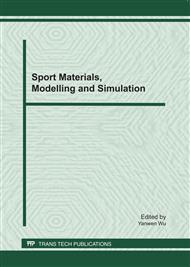[1]
Y. Zhong. Application and prospects of information technology in sports training. Journal of Wuhan Institute of Physical Education. 2008, 42(6): 52-55.
Google Scholar
[2]
L. Yu and D. Wu. Discussion on Adjustment of Movement Structure Model and Technical Deviation of Gymnastics. China Sport Science and Technology. 2004, 40(6): 13-14.
Google Scholar
[3]
Z. Li, H. Zhang, J. Gu and G. Chen. Dynamic parameter identification of three-link acrobot on horizontal bar. Control Theory & Applications. 2008, 25(2): 68-72.
Google Scholar
[4]
J.G. Qian, S. L. Meng and X. Tang. Biomechanical Principle of Gymnastics of Horizontal Bar. Journal of Nanjing Institute of Physical Education: Natural Science. 2007, 6(3): 1-5.
Google Scholar
[5]
W.L. Bauer. Hip Control Mechanism of a Gymnasts' Giant Swing Maneuver. Biomechanics, Ⅶ- B, 1981: 548- 552.
Google Scholar
[6]
W.L. Bauer. Swinging as a Way of Increasing the Mechanical Energy in Gymnastic Maneuvers. Biomechanics, Ⅷ- B, 1983: 801- 806.
Google Scholar
[7]
W.L. Bauer. Manually Operated Biomechanical Model of an Internally Energized Self- Oscillatory System. Biomechanics, IX- B, 1985: 383- 388.
Google Scholar
[8]
W.L. Bauer. Physical Model in Sports Biomechanics. Med. Sport Sci., vol. 25, pp: 107- 141 (Karger, Based1987).
Google Scholar
[9]
J. Shi, S. S. Jiang, X. Zhang and X. Chen Status Quo and Trend of Research and Simulation on Human-gait. Journal of System Simulation. 2006, 18(10): 2703-2708.
Google Scholar
[10]
H. A. Hatze. Comprehensive model for human motion simulation and its application to the take-off phase of the long jump. Journal of Biomechanics, 1981, 3.
DOI: 10.1016/0021-9290(81)90019-1
Google Scholar
[11]
T. R. Kane. Experimental investigation of astronaut maneuvering scheme. Journal of Biomechanics, 972, 5.
Google Scholar


